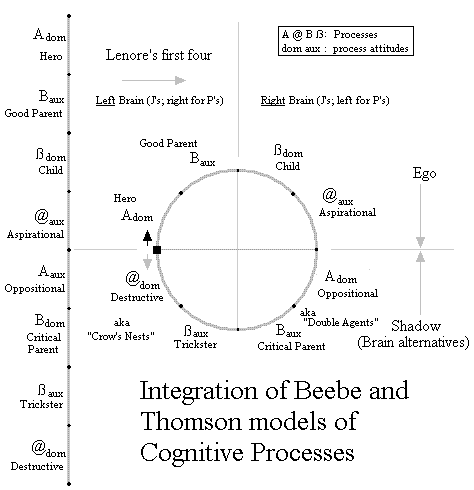What do you think of the list there vs. Thomson for INTJ:
[Beebe]: Ni Te Fi Se Ne Ti Fe Si
Thomson: Ni Te Si Fe Ti Ne Fi Se
Seems to me that the INTJs I know are pretty fact and detail friendly (Si), and that part isn't their deepest darkest shadow function. How about the relative positions of Fi vs Fe on those two lists? Do you relate more to one of those functions than the other?
The thing about Lenore Thomson's model, is that it does not seem to be intended to really be a strict, hard "order" of functions; strength or otherwise. I did use to think that, when I made the illustration which I was discussing here awhile ago:
http://www.erictb.info/beebethomson.gif. (And likewise, Beebe's order is not one of strengths). But then, when I conversed with her myself, she clarified it, and the results can be seen here:
John Beebe Archetypes | Lenore Thomson Bentz
It seems people's main sources for her teaching are:
The Lenore Thomson Exegesis Wiki
What's New In Type and Temperament
Jungian cognitive functions - Wikipedia, the free encyclopedia
The latter two are what give this "order". But I'm not sure if that actually came from her book, or it's just people's
interpretation of her. At our last NYC Meetup, someone had the book, and I had a chance to glance at it, but never got around to finding it either online, or at the library (It had been lost from two of them!)
In the personalitypage article, she points out that she does acknowledge Beebe's order, but cautions it should be understood as
complexes. We think of the archetypes as the processes, but they are really ego complexes that employ the functions, and outside of those complexes, the functions are likely "undifferentiated", and hence, any person can engage in any behavior associated with any function.
She even uses Beebe's terms "trickster" and "demon", which would correspond to her "Crow's Nests" or right or left brain alternatives. She also points out that their manifestation is not ordinary, but occurs when there is danger of ego-disintegration or the ego is ready to grow or individuate (some of this was edited out of the article).
This would differ from Beebe.
So having Fe and Ni as what appears to be tertiary and inferior positions for an ESTJ is not really saying what one may think it is. She still holds Ne and Fi as tertiary and inferior, though on those lists, they are on the bottom. It's just that Fe and Ni will come up as the left brain alternatives to Te and Si, however, it will still usually be in negative situations of stress associated with Beebe's trickster and demon archetypes, or 7th/8th place functions. You can even see Ni discussed for the ESTJ here:
John Beebe
Again, Beebe's order is not about strength. So the tertiary and inferior may actually be the weakest. For one thing,
they will be the less developed of the conscious functions. The shadows (other four) may appear to be stronger in comparison, if they come up a lot,
and they will be very noticeable, as they are "not ourselves", as it has been put.
Again, as I have been saying recently; the way the shadows work is that there are four functions. The ego chooses them in a particular order, and uses each in one orientation or the other. The rejected orientation will remain in the unconscious. The ego has four complexes for each of the four functions, and the rejected function orientations will end up being employed by the rejected aspects of those complexes.
So our ego's dominant function and orientation is used by a complex described as "
heroic". The rejected orientation will be used by a rejected aspect of the hero, called an "
opposing personality".
The auxiliary is used by a
parent complex. what's rejected from that will be held by a "critical paren"t, or "
witch/senex" complex.
The tertiary is held by a
child or puer complex (which orients it in the dominant attitude, as Lenore points out). The opposite orientation rejected by that will form a bad child complex, called a "
trickster".
And the
anima/animus is like the deep soul or something, and what's rejected from that will form a "
demonic" personality complex.
That's what Beebe's order is about; not strengths.
You can see where I build up the model from scratch, here:
Temperament Part 2: The MBTI's 16 types and Cognitive Functions
